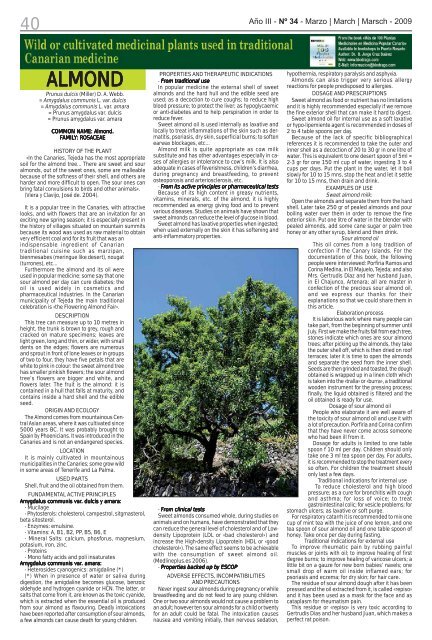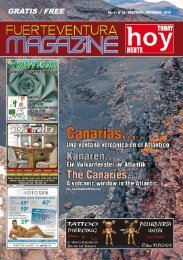actualidad local - fuerteventura magazine hoy
actualidad local - fuerteventura magazine hoy
actualidad local - fuerteventura magazine hoy
Create successful ePaper yourself
Turn your PDF publications into a flip-book with our unique Google optimized e-Paper software.
40<br />
ALMOND<br />
ALMOND<br />
PROPERTIES AND THERAPEUTIC INDICATIONS<br />
- From om traditional traditional use<br />
use<br />
In popular medicine the external shell of sweet<br />
Prunus dulcis (Miller) D. A. Webb.<br />
almonds and the hard hull and the edible seed are<br />
= Amygdalus communis L. var. dulcis used; as a decoction to cure coughs; to reduce high<br />
= Amygdalus communis L. var. amara blood pressure; to protect the liver; as hypoglycaemic<br />
= Prunus amygdalus var. dulcis<br />
or anti-diabetes and to help perspiration in order to<br />
= Prunus amygdalus var. amara<br />
reduce fever.<br />
Sweet almond oil is used internally as laxative and<br />
COMMON COMMON COMMON NAME: NAME: Almond.<br />
Almond.<br />
<strong>local</strong>ly to treat inflammations of the skin such as der-<br />
FAMIL AMIL AMILY: AMIL : R RROSA<br />
R OSA OSACEAE OSA CEAE<br />
matitis, psoriasis, dry skin, superficial burns; to soften<br />
earwax blockages, etc…<br />
HISTORY OF THE PLANT<br />
Almond milk is quite appropriate as cow milk<br />
«In the Canaries, Tejeda has the most appropriate<br />
substitute and has other advantages especially in ca-<br />
soil for the almond tree… There are sweet and sour<br />
ses of allergies or intolerance to cow’s milk. It is also<br />
almonds, out of the sweet ones, some are malleable<br />
adequate in cases of feverishness, children’s diarrhea,<br />
because of the softness of their shell, and others are<br />
during pregnancy and breastfeeding, to prevent<br />
harder and more difficult to open. The sour ones can<br />
osteoporosis and arteriosclerosis, etc.<br />
bring fatal convulsions to birds and other animals».<br />
- From om its its activ active activ activ e principles principles principles or or pharmaceutical pharmaceutical t ttes<br />
t es ests es ts<br />
(Viera y Clavijo, José de. 2004).<br />
Because of its high content in greasy nutrients,<br />
vitamins, minerals, etc. of the almond, it is highly<br />
It is a popular tree in the Canaries, with attractive<br />
recommended as energy giving food and to prevent<br />
looks, and with flowers that are an invitation for an<br />
various diseases. Studies on animals have shown that<br />
exciting new spring season; it is especially present in<br />
sweet almonds can reduce the level of glucose in blood.<br />
the history of villages situated on mountain summits<br />
Sweet almond has laxative properties when ingested;<br />
because its wood was used as raw material to obtain<br />
when used externally on the skin it has softening and<br />
very efficient coal and for its fruit that was an<br />
anti-inflammatory properties.<br />
indispensable ingredient of Canarian<br />
traditional cuisine such as marzipan,<br />
bienmesabes (meringue like desert), nougat<br />
(turrones), etc…<br />
Furthermore the almond and its oil were<br />
used in popular medicine: some say that one<br />
sour almond per day can cure diabetes; the<br />
oil is used widely in cosmetics and<br />
pharmaceutical industries. In the Canarian<br />
municipality of Tejeda the main traditional<br />
celebration is «the Flowering Almond Fair».<br />
DESCRIPTION<br />
This tree can measure up to 10 metres in<br />
height, the trunk is brown to grey, rough and<br />
cracked on mature specimens; leaves are<br />
light green, long and thin, or wider, with small<br />
dents on the edges; flowers are numerous<br />
and sprout in front of lone leaves or in groups<br />
of two to four, they have five petals that are<br />
white to pink in colour: the sweet almond tree<br />
has smaller pinkish flowers; the sour almond<br />
tree’s flowers are bigger and white, and<br />
flowers later. The fruit is the almond: it is<br />
contained in a hull that falls at maturity, and<br />
contains inside a hard shell and the edible<br />
seed.<br />
ORIGIN AND ECOLOGY<br />
The Almond comes from mountainous Central<br />
Asian areas, where it was cultivated since<br />
5000 years BC. It was probably brought to<br />
Spain by Phoenicians. It was introduced in the<br />
Canaries and is not an endangered species.<br />
LOCATION<br />
It is mainly cultivated in mountainous<br />
municipalities in the Canaries; some grow wild<br />
in some areas of Tenerife and La Palma.<br />
USED PARTS<br />
Shell, fruit and the oil obtained from them.<br />
FUNDAMENTAL ACTIVE PRINCIPLES<br />
Am Amygdalus Am gdalus communis communis v vvar<br />
v ar ar. ar . dulcis dulcis y y amara:<br />
amara:<br />
- Mucilage<br />
- From om clinical clinical t ttes<br />
t tes<br />
es ests es ts<br />
- Phytosterols: cholesterol, campestrol, sitgmasterol, Sweet almonds consumed whole, during studies on<br />
beta sitosterol.<br />
animals and on humans, have demonstrated that they<br />
- Enzymes: emulsine.<br />
can reduce the general level of cholesterol and of Low-<br />
- Vitamins: A, B1, B2, PP, B5, B6, E<br />
density Lipoprotein (LDL or «bad cholesterol») and<br />
- Mineral Salts: calcium, phosforus, magnesium,<br />
increase the High-density Lipoprotein (HDL or «good<br />
potasium, iron, zinc.<br />
cholesterol»). The same effect seems to be achievable<br />
- Proteins<br />
- Mono fatty acids and poli insaturates<br />
with the consumption of sweet almond oil.<br />
Am Amygdalus Am gdalus communis communis v vvar<br />
v ar ar. ar . amara:<br />
amara:<br />
(Medlineplus.es 2006).<br />
- Heterosides cyanogenics: amigdaline (*)<br />
- Pr Pr Proper Pr Pr oper operties operties<br />
ties bac bac backed bac bac ed up up b bby<br />
b by<br />
y ESCOP ESCOP<br />
ESCOP<br />
(*) When in presence of water or saliva during ADVERSE EFFECTS, INCOMPATIBILITIES<br />
digestion, the amigdaline becomes glucose, benzoic<br />
AND PRECAUTIONS<br />
aldehyde and hydrogen cyanide or HCN. The latter, or Never ingest sour almonds during pregnancy or while<br />
salts that come from it, are known as the toxic cyanide, breastfeeding and do not feed to any young children.<br />
which is extracted when the essential oil is produced One or two sour almonds would not cause a problem to<br />
from sour almond as flavouring. Deadly intoxications an adult; however ten sour almonds for a child or twenty<br />
have been reported after consumption of sour almonds, for an adult could be fatal. The intoxication causes<br />
a few almonds can cause death for young children. nausea and vomiting initially, then nervous sedation,<br />
Año III - Nº 34 - Marzo | March | Marsch - 2009<br />
hypothermia, respiratory paralysis and asphyxia.<br />
Almonds can also trigger very serious allergy<br />
reactions for people predisposed to allergies.<br />
DOSAGE AND PRESCRIPTIONS<br />
Sweet almond as food or nutrient has no limitations<br />
and it is highly recommended especially if we remove<br />
the fine exterior shell that can make it hard to digest.<br />
Sweet almond oil for internal use as a soft laxative<br />
or hypo-lipemiente agent is recommended in doses of<br />
2 to 4 table spoons per day.<br />
Because of the lack of specific bibliographical<br />
references it is recommended to take the outer and<br />
inner shell as a decoction of 20 to 30 gr in one litre of<br />
water. This is equivalent to one desert spoon of 5ml =<br />
2-3 gr for one 150 ml cup of water, ingesting 3 to 4<br />
cups per days. Put the plant in the water, let it boil<br />
slowly for 10 to 15 mns, stop the heat and let it settle<br />
for 10 to 15 mns, then drain and drink.<br />
EXAMPLES OF USE<br />
Sweet almond milk:<br />
Open the almonds and separate them from the hard<br />
shell. Later take 250 gr of pealed almonds and pour<br />
boiling water over them in order to remove the fine<br />
exterior skin. Put one litre of water in the blender with<br />
pealed almonds, add some cane sugar or palm tree<br />
honey or any other syrup, blend and then drink.<br />
Sour almond oil<br />
This oil comes from a long tradition of<br />
confection if the Canary Islands. For the<br />
documentation of this book, the following<br />
people were interviewed: Porfiria Ramos and<br />
Corina Medina, in El Majuelo, Tejeda; and also<br />
Mrs. Gertrudis Díaz and her husband Juan,<br />
in El Chajunco, Artenara; all are master in<br />
confection of the precious sour almond oil,<br />
and we express our thanks for their<br />
explanations so that we could share them in<br />
this article.<br />
Elaboration process<br />
It is laborious work where many people can<br />
take part, from the beginning of summer until<br />
July. First we make the fruits fall from each tree,<br />
stones indicate which ones are sour almond<br />
trees; after picking up the almonds, they take<br />
the outer shell off, which is then dried on roof<br />
terraces; later it is time to open the almonds<br />
and separate the seed from the inner shell.<br />
Seeds are then grinded and toasted, the dough<br />
obtained is wrapped up in a linen cloth which<br />
is taken into the «tralla» or «burra», a traditional<br />
wooden instrument for the pressing process;<br />
finally, the liquid obtained is filtered and the<br />
oil obtained is ready for use.<br />
Dosage of sour almond oil<br />
People who elaborate it are well aware of<br />
the toxicity of sour almond oil and use it with<br />
a lot of precaution. Porfiria and Corina confirm<br />
that they have never come across someone<br />
who had been ill from it.<br />
Dosage for adults is limited to one table<br />
spoon f 10 ml per day. Children should only<br />
take one 3 ml tea spoon per day. For adults,<br />
it is recommended to stop the treatment every<br />
so often. For children the treatment should<br />
only last a few days.<br />
Traditional indications for internal use<br />
To reduce cholesterol and high blood<br />
pressure; as a cure for bronchitis with cough<br />
and asthma; for loss of voice; to treat<br />
gastrointestinal colic; for vesicle problems; for<br />
stomach ulcers; as laxative or soft purge.<br />
For respiratory catarrh it is recommended to mix one<br />
cup of mint tea with the juice of one lemon, and one<br />
tea spoon of sour almond oil and one table spoon of<br />
honey. Take once per day during fasting.<br />
Traditional indications for external use<br />
To improve rheumatic pain by rubbing painful<br />
muscles or joints with oil; to improve healing of first<br />
degree burns; to improve healing of varicose ulcers; a<br />
little bit on a gauze for new born babies’ navels; one<br />
small drop of warm oil inside inflamed ears; for<br />
psoriasis and eczema; for dry skin; for hair care.<br />
The residue of sour almond dough after it has been<br />
pressed and the oil extracted from it, is called «repiso»<br />
and it has been used as a mask for the face and as<br />
cataplasm for rheumatism pain.<br />
This residue or «repiso» is very toxic according to<br />
Gertrudis Días and her husband Juan, which makes a<br />
perfect rat poison.














